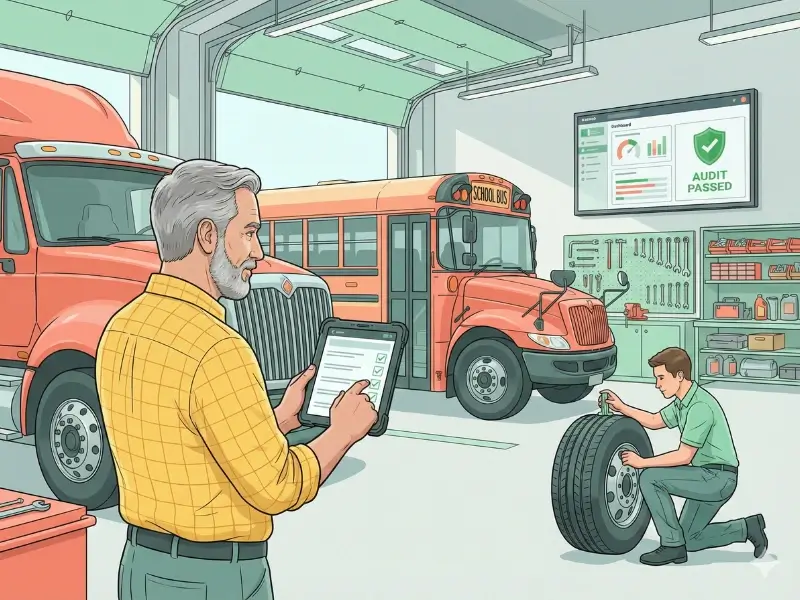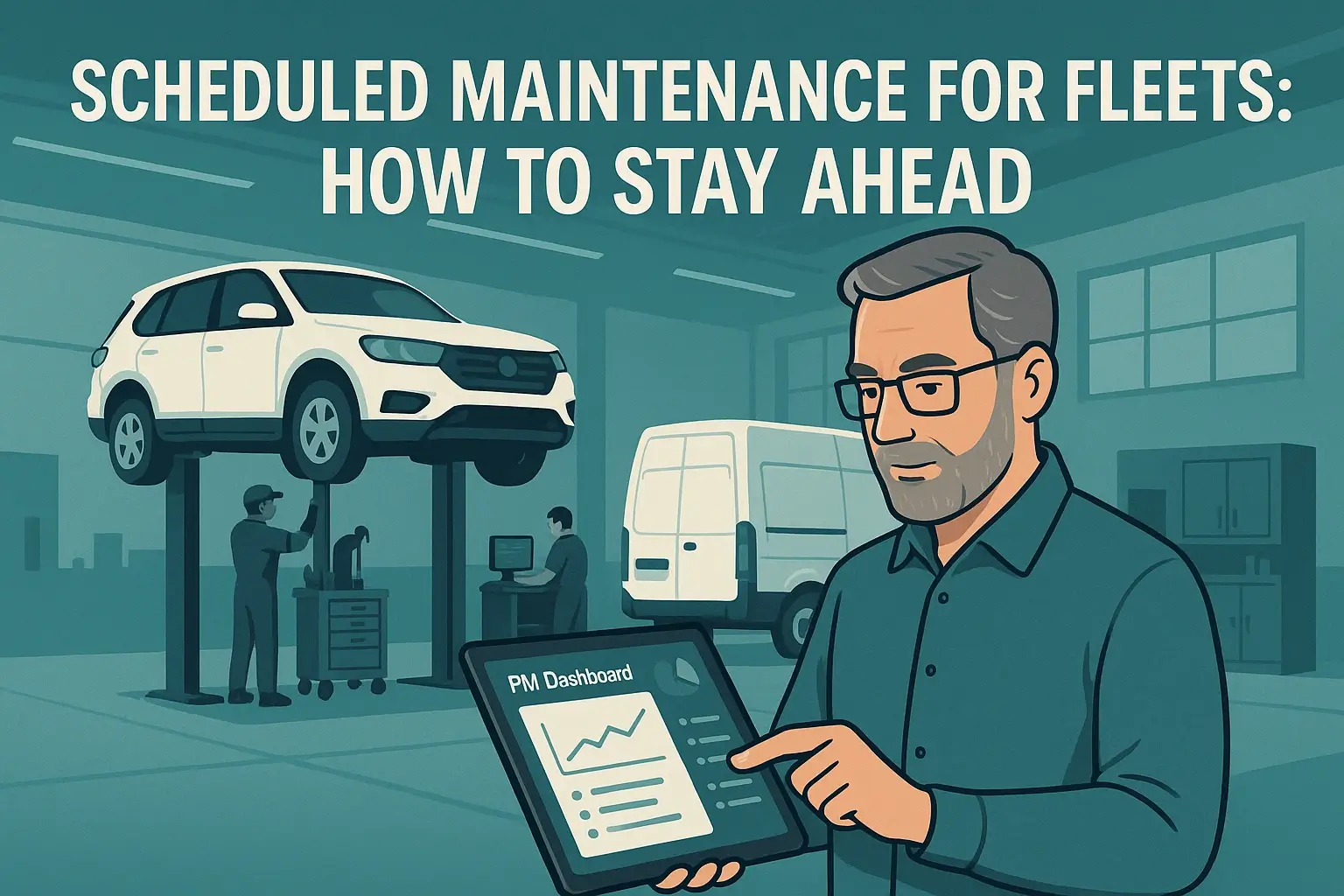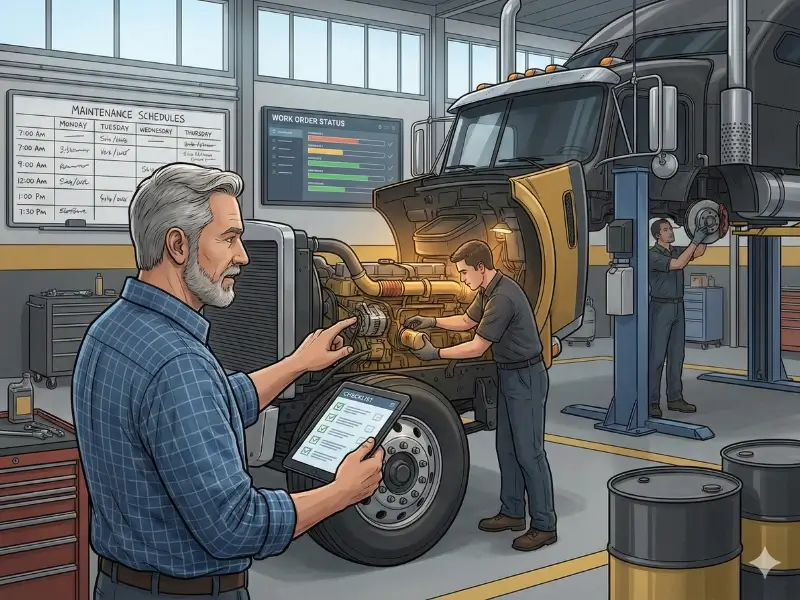Key Takeaways
Introduction
Imagine this: A fleet manager who never scrambles to fix unexpected breakdowns. Instead, every vehicle runs smoothly, costs stay predictable, and downtime is minimal. The secret? A well-structured preventive maintenance schedule.
Reactive maintenance—fixing problems only after they occur—is expensive and disruptive. A preventive maintenance schedule ensures your fleet operates at peak performance, reduces costly repairs, and extends asset life.
Without proper scheduling, even minor delays in maintenance can lead to severe damage, compliance issues, and operational inefficiencies. That’s why preventive maintenance scheduling is critical—not just to keep your fleet in motion but also to enhance safety, optimize costs, and ensure regulatory compliance.
Let’s break down how to create and optimize a preventive maintenance schedule that keeps your operations running efficiently.
What is a Preventive Maintenance Schedule?
A preventive maintenance schedule is a structured plan for servicing equipment and vehicles at regular intervals. It includes routine inspections, scheduled repairs, and timely part replacements to prevent failures before they happen.
Unlike reactive maintenance, where issues are only addressed after breakdowns occur, a preventive maintenance schedule proactively keeps assets in top shape, reducing downtime and long-term costs.
Key Benefits of Preventive Maintenance Scheduling:
- Reduces Unexpected Equipment Failures – Identifies issues before they escalate.
- Extends Equipment Lifespan – Keeps vehicles running longer with fewer major repairs.
- Improves Workplace Safety – Ensures compliance with fleet safety standards.
- Controls Maintenance Costs – Prevents costly emergency repairs.
- Enhances Fleet Efficiency – Increases uptime and reliability.
- Ensures Regulatory Compliance – Helps meet legal and safety requirements.
Reduces Administrative Burden – Automates scheduling, tracking, and reporting.
Download Our Free Fleet Maintenance Resources Now!
How to Create a Preventive Maintenance Schedule
1. Identify Fleet Maintenance Priorities
Start by outlining your organization’s top maintenance goals. These could include:
- Minimizing downtime to avoid delivery delays.
- Extending asset life to reduce vehicle replacement costs.
- Lowering repair expenses by preventing major failures.
- Enhancing compliance to meet legal and safety standards.
- Boosting fuel efficiency through optimized servicing.
2. Build a Comprehensive Asset Inventory
For an effective preventive maintenance schedule, list every vehicle and asset, including:
- Make, model, and year
- Current mileage and usage history
- Unique identifiers (VIN, license plate, or internal asset number)
- Maintenance history
- Operational environment (e.g., harsh weather, heavy loads)
- Criticality assessment (Which vehicles are business-critical?)
3. Refer to Manufacturer Recommendations
Every vehicle has a recommended preventive maintenance schedule from the manufacturer. Follow these guidelines for tasks such as:
- Oil changes
- Tire rotations
- Brake inspections
- Filter replacements
- Fluid checks
- Battery testing and replacement
- Suspension and alignment checks
4. Set Maintenance Triggers
A preventive maintenance schedule relies on accurate maintenance triggers, such as:
- Time-based triggers (e.g., every 3 months or 10,000 miles)
- Usage-based triggers (e.g., after 500 engine hours)
- Condition-based triggers (e.g., sensor alerts for fluid levels or tire pressure)
- Failure analysis triggers (e.g., data-driven insights from past failures)
5. Use Preventive Maintenance Checklists
Standardized checklists ensure maintenance tasks are completed consistently. Your checklist should include:
- Pre-trip inspections (e.g., tire pressure, lights, fluids)
- Routine servicing (e.g., oil and filter changes, brake checks)
- Seasonal maintenance (e.g., winterizing vehicles, checking A/C systems in summer)
- Compliance checks (e.g., emission tests, DOT inspections)
6. Leverage Preventive Maintenance Software
A fleet maintenance software automates scheduling, tracks maintenance history, and sends alerts for upcoming services.
Look for software that allows you to:
- Schedule automated maintenance reminders
- Track vehicle health trends
- Generate real-time reports on maintenance costs and efficiency
- Integrate with telematics systems for real-time monitoring
- Optimize parts inventory management to prevent stockouts
7. Train Your Team for Consistency
A preventive maintenance schedule only works if your team follows it. Provide training for:
- Drivers (to report issues early)
- Technicians (to follow standardized procedures)
- Fleet managers (to oversee scheduling and compliance)
- Maintenance coordinators (to track and manage repairs efficiently)
8. Track Key Performance Indicators (KPIs)
Measuring success ensures your preventive maintenance schedule remains effective. Track these KPIs:
- Planned maintenance percentage (PMP) – How much maintenance is scheduled vs. reactive.
- Mean time between failures (MTBF) – How often assets require repairs.
- Preventive maintenance compliance – How consistently maintenance is performed on schedule.
- Maintenance cost per mile – How much each asset costs in repairs.
- Fuel efficiency trends – How preventive maintenance impacts fuel usage.
Related Posts:
- Reactive vs. Preventive Maintenance: Which Strategy Saves You Time and Money?
- Is My Fleet Too Small for Maintenance Software?
- Do I Need Fleet Maintenance Software in 2025? A Checklist for Managers
Final Thoughts & Next Steps
🚀 Take Action Now:
- Download our Preventive Maintenance Checklist to streamline your maintenance process.
- Explore Simply Fleet’s fleet maintenance software for automated scheduling and real-time tracking.
- Schedule a free consultation to see how optimized preventive maintenance can save you time and money.
Proactive maintenance isn’t just an option—it’s the key to long-term success. Start optimizing your preventive maintenance scheduling today! 🚛✨



.png)








.png)


.png)









